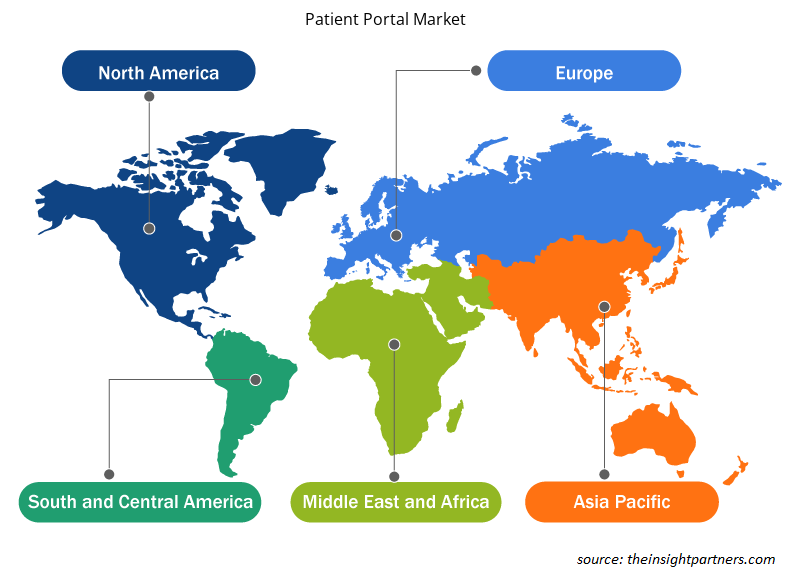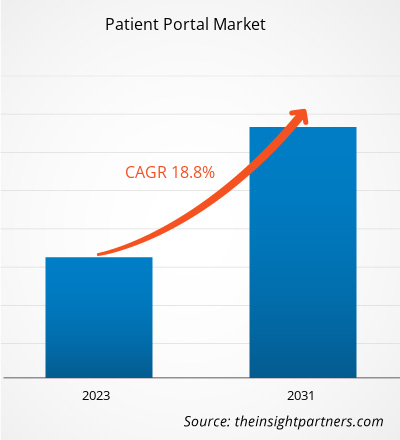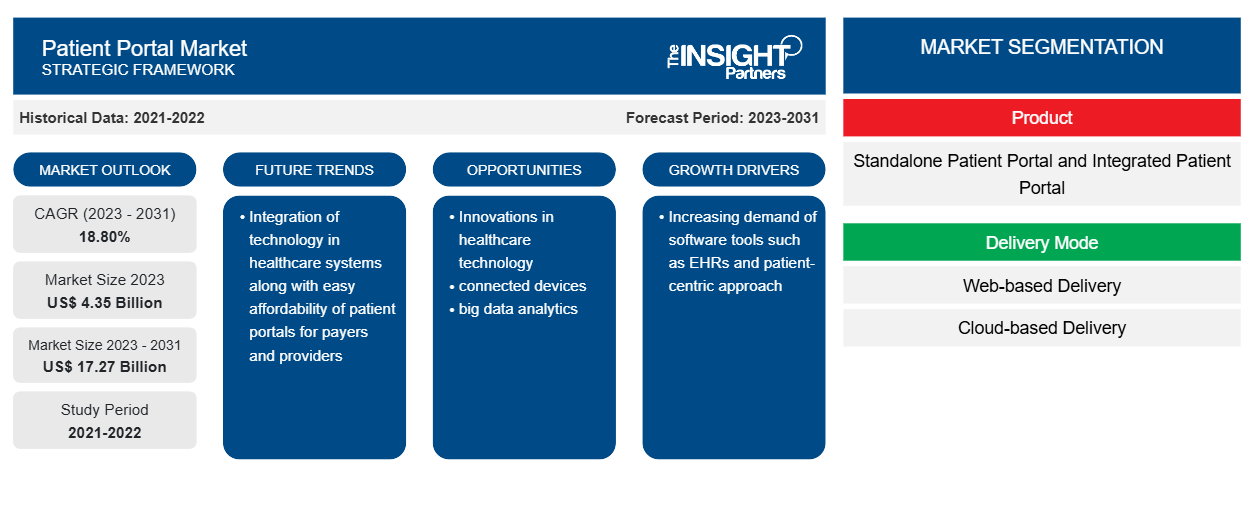Der Markt für Patientenportale soll von 4,35 Milliarden US-Dollar im Jahr 2023 auf 17,27 Milliarden US-Dollar im Jahr 2031 anwachsen. Der Markt soll zwischen 2023 und 2031 eine durchschnittliche jährliche Wachstumsrate (CAGR) von 18,80 % verzeichnen. Die zunehmende Akzeptanz des patientenzentrierten Ansatzes der Kostenträger im Gesundheitswesen und die wachsende Nachfrage nach elektronischen Gesundheitsakten (EHR) zur Verbesserung der Patienteneinbindung werden voraussichtlich weiterhin wichtige Trends auf dem Markt für Patientenportale bleiben.
Patientenportal-Marktanalyse
Patienten greifen über Online-Portale auf ihre elektronische Gesundheitsakte (EHR) zu, ein potenzielles Instrument zur Verbesserung der Patienteneinbindung. Mit der Erweiterung von Programmierschnittstellen zur Steigerung des bidirektionalen Datenflusses mit Patienten und zur Vereinfachung des Zugriffs auf Patientendaten wie klinische Notizen wird erwartet, dass die potenziellen Auswirkungen der Patienteneinbindung durch die Implementierung dieser Plattformen in den kommenden Jahren zunehmen werden. Laut den Daten aus den Annals of Internal Medicine im Jahr 2020 bieten etwa 90 % der US-Gesundheitssysteme und -anbieter Patienten einen Online-Portalzugriff auf ihre EHR-Daten. Allerdings nutzen nur 15–30 % der Patienten diese Plattformen. Die Nutzung eines Patientenportals ist auf bestimmte Umgebungen wie die ambulante Versorgung in einem integrierten Versorgungssystem beschränkt.
Patientenportal-Marktübersicht
Nordamerika ist der größte Markt für das Wachstum des Patientenportalmarktes, wobei die USA den größten Marktanteil in der Region halten, gefolgt von Kanada. Mit dem Wachstum der Digitalisierung im Gesundheitswesen nimmt die Nutzung von EHRs rasant zu. Laut den von der WHO vorgelegten Daten sind in etwa 50 % aller Länder weltweit nationale EHR-Systeme implementiert. Darüber hinaus heißt es in einem im Oktober 2023 im Journal of Health Affairs Scholar veröffentlichten Artikel, dass große Krankenhäuser eine um etwa 7 % höhere umfassende EHR-Einführungsrate aufweisen als mittelgroße Krankenhäuser, d. h. über 34 %. Allerdings liegen ländliche Krankenhäuser bei der umfassenden EHR-Einführung um 12 % hinter städtischen Gebieten zurück. Der wachsende Bedarf an EHRs und eine zunehmende Einbeziehung patientenzentrierter Techniken durch die Kostenträger im Gesundheitswesen sind einige Faktoren, die zum Wachstum des Patientenportalmarktes in den USA beitragen.
Passen Sie diesen Bericht Ihren Anforderungen an
Sie erhalten kostenlos individuelle Anpassungen an jedem Bericht, einschließlich Teilen dieses Berichts oder einer Analyse auf Länderebene, eines Excel-Datenpakets sowie tolle Angebote und Rabatte für Start-ups und Universitäten.
-
Holen Sie sich die wichtigsten Markttrends aus diesem Bericht.Dieses KOSTENLOSE Beispiel umfasst eine Datenanalyse von Markttrends bis hin zu Schätzungen und Prognosen.
Treiber und Chancen auf dem Patientenportalmarkt
Zunehmende Akzeptanz des patientenzentrierten Ansatzes bei den Kostenträgern im Gesundheitswesen
Patientenportale sind ein wichtiges Instrument für Lösungen zur Patienteneinbindung. Diese Lösung wird in Bezug auf die Nutzung unter der alternden Bevölkerung immer beliebter. Softwarehersteller entwickeln dieses Patientenportal in Form von webbasierten oder mobilbasierten Anwendungen. Auf diesem Portal können Patienten ihre Daten einfach speichern und darauf zugreifen. Darüber hinaus konzentrieren sich Regierungen verschiedener Länder auf der ganzen Welt auf die Festlegung von Vorschriften, Infrastrukturen und Standards für die Führung von Gesundheitsakten. So wurde beispielsweise die Plattform My Health Record, Australiens nationale digitale Gesundheitsaktenplattform, entwickelt, um im Jahr 2022 die eigenen Gesundheitsakten der Patienten zu sichern. Patienten in Australien, die Medicare oder eine individuelle Gesundheitskennung (IHI) besitzen, können My Health Record verwenden. Die Verwendung solcher digitaler Gesundheitsplattformen durch Gesundheitsdienstleister kann den Abruf der auf der Plattform gespeicherten Gesundheitsdaten erleichtern. Somit treibt die zunehmende Einführung eines patientenzentrierten Ansatzes durch die Gesundheitszahler den Markt für Patientenportale an.IHI) can use My Health Record. The use of such digital health platforms by healthcare providers can facilitate the retrieval of healthcare data stored on the platform. Thus, the rising adoption of a patient-centric approach by healthcare payers drives the patient portal market.
Steigende Gesundheitsausgaben für digitale Gesundheitslösungen
Gesundheitsdienstleister erkennen die Bedeutung der Implementierung effizienter und patientenzentrierter Lösungen. Softwareanbieter und Forschungseinrichtungen investieren in digitale Gesundheitstechnologien, um die Patienteneinbindung zu verbessern und Verwaltungsprozesse zu optimieren. Patientenportale haben sich als Schlüsselkomponente für digitale Gesundheitslösungen herausgestellt und bieten Patienten eine sichere und zugängliche Plattform, um auf ihre Gesundheitsinformationen zuzugreifen und mit Gesundheitsdienstleistern zu kommunizieren. Investitionen in diese Patientenportale werden durch die Möglichkeit vorangetrieben, durch eine bessere Koordinierung der Pflege und verbesserte Patientenergebnisse Kosteneinsparungen zu erzielen. Die steigenden Gesundheitsausgaben für digitale Gesundheitslösungen dürften im Prognosezeitraum lukrative Möglichkeiten für das Wachstum des Patientenportalmarktes schaffen.patient-centric solutions. Software providers and research institutions are investing in digital health technologies to improve patient engagement and streamline administrative processes. Patient portals have emerged as a key component for digital health solutions, providing a secure and accessible platform for patients to access their
Patientenportal-Marktbericht – Segmentierungsanalyse
Wichtige Segmente, die zur Ableitung der Marktanalyse für Patientenportale beigetragen haben, sind Dienste, Dienstanbieter und Endbenutzer.
- Basierend auf dem Produkt ist der Patientenportalmarkt in ein eigenständiges Patientenportal und ein integriertes Patientenportal segmentiert. Das Segment der integrierten Patientenportale hatte 2023 einen größeren Marktanteil. Das integrierte Patientenportal funktioniert als Modul, das einem zusätzlichen EHR/EMR oder einem anderen Gesundheitssystem hinzugefügt wird.EHR/EMR or any other healthcare system.
- Nach Liefermodus ist der Markt in webbasierte und cloudbasierte Modi unterteilt. Das Segment des webbasierten Modus hielt im Jahr 2023 einen größeren Marktanteil. Der cloudbasierte Modus wird voraussichtlich zwischen 2023 und 2031 eine höhere CAGR verzeichnen.CAGR during 2023–2031.
- Nach Endverbraucher ist der Markt in Kostenträger, Anbieter, Apotheken und andere segmentiert. Das Anbietersegment hielt im Jahr 2023 den größten Marktanteil. Dieses Segment umfasst Krankenhäuser, ambulante Pflegezentren und Pflegeheime.
Marktanteilsanalyse für Patientenportale nach geografischer Lage
Der geografische Umfang des Marktberichts zum Patientenportal ist hauptsächlich in fünf Regionen unterteilt: Nordamerika, Asien-Pazifik, Europa, Naher Osten und Afrika sowie Süd- und Mittelamerika.
Nordamerika dominiert den Markt für Patientenportale. Das Marktwachstum ist auf steigende staatliche Forschungs- und Entwicklungsausgaben für Krankenhäuser in Nordamerika und die zunehmende Nutzung von Patientenportalen durch Biotechnologie- und Pharmaunternehmen zurückzuführen.
Patientenportal
Regionale Einblicke in den Patientenportalmarkt
Die regionalen Trends und Faktoren, die den Patientenportalmarkt während des Prognosezeitraums beeinflussen, wurden von den Analysten von Insight Partners ausführlich erläutert. In diesem Abschnitt werden auch Patientenportalmarktsegmente und -geografie in Nordamerika, Europa, im asiatisch-pazifischen Raum, im Nahen Osten und Afrika sowie in Süd- und Mittelamerika erörtert.

- Erhalten Sie regionalspezifische Daten zum Patientenportalmarkt
Umfang des Marktberichts zum Patientenportal
| Berichtsattribut | Details |
|---|---|
| Marktgröße im Jahr 2023 | 4,35 Milliarden US-Dollar |
| Marktgröße bis 2031 | 17,27 Milliarden US-Dollar |
| Globale CAGR (2023 - 2031) | 18,80 % |
| Historische Daten | 2021-2022 |
| Prognosezeitraum | 2023–2031 |
| Abgedeckte Segmente |
Nach Produkt
|
| Abgedeckte Regionen und Länder |
Nordamerika
|
| Marktführer und wichtige Unternehmensprofile |
|
Dichte der Marktteilnehmer für Patientenportale: Die Auswirkungen auf die Geschäftsdynamik verstehen
Der Markt für Patientenportale wächst rasant, angetrieben durch die steigende Nachfrage der Endnutzer aufgrund von Faktoren wie sich entwickelnden Verbraucherpräferenzen, technologischen Fortschritten und einem größeren Bewusstsein für die Vorteile des Produkts. Mit steigender Nachfrage erweitern Unternehmen ihr Angebot, entwickeln Innovationen, um die Bedürfnisse der Verbraucher zu erfüllen, und nutzen neue Trends, was das Marktwachstum weiter ankurbelt.
Die Marktteilnehmerdichte bezieht sich auf die Verteilung der Firmen oder Unternehmen, die in einem bestimmten Markt oder einer bestimmten Branche tätig sind. Sie gibt an, wie viele Wettbewerber (Marktteilnehmer) in einem bestimmten Marktraum im Verhältnis zu seiner Größe oder seinem gesamten Marktwert präsent sind.
Die wichtigsten auf dem Patientenportalmarkt tätigen Unternehmen sind:
- Cerner Corporation,
- Allscripts Gesundheitswesen,
- Epic System Corporation,
- Grüner Weg,
- athenahealth
- CureMD Gesundheitswesen
Haftungsausschluss : Die oben aufgeführten Unternehmen sind nicht in einer bestimmten Reihenfolge aufgeführt.

- Überblick über die wichtigsten Akteure auf dem Patientenportalmarkt
Neuigkeiten und aktuelle Entwicklungen zum Patientenportal-Markt
Der Markt für Patientenportale wird durch die Erhebung qualitativer und quantitativer Daten aus Primär- und Sekundärforschung bewertet, die wichtige Unternehmenspublikationen, Verbandsdaten und Datenbanken umfasst. Nachfolgend sind einige der Entwicklungen auf dem Markt für Patientenportale aufgeführt:
- Koblenz. CompuGroup Medical SE & Co. KGaA übernimmt 51% der m.Doc GmbH. m.Doc entwickelt Patientenportale und digitale Anwendungen für Krankenhäuser, Reha- und Pflegeeinrichtungen. (Quelle: CompuGroup Medical, Pressemitteilung/Unternehmenswebsite/Newsletter, April 2023)
- Reveleer, ein Unternehmen für Gesundheitstechnologie, das natürliche Sprachverarbeitung (NLP) und künstliche Intelligenz (KI) nutzt, um datengesteuerte Gesundheitsversorgung für Krankenkassen und risikotragende Anbieter zu ermöglichen, hat MDPortals übernommen, eine erstklassige prospektive Risikoanpassungsplattform. (Quelle: Reveleer, Pressemitteilung/Unternehmenswebsite/Newsletter, Juni 2021)
Marktbericht zum Patientenportal – Umfang und Ergebnisse
Der Bericht „Marktgröße und Prognose für Patientenportale (2021–2031)“ bietet eine detaillierte Analyse des Marktes, die die folgenden Bereiche abdeckt:
- Patientenportal-Marktgröße und -prognose auf globaler, regionaler und Länderebene für alle wichtigen Marktsegmente, die im Rahmen des Berichts abgedeckt sind
- Patientenportal-Markttrends sowie Marktdynamik wie Treiber, Einschränkungen und wichtige Chancen
- Detaillierte PEST/Porters Five Forces- und SWOT-Analyse
- Marktanalyse für Patientenportale mit Blick auf wichtige Markttrends, globale und regionale Rahmenbedingungen, wichtige Akteure, Vorschriften und aktuelle Marktentwicklungen
- Branchenlandschaft und Wettbewerbsanalyse, einschließlich Marktkonzentration, Heatmap-Analyse, prominenten Akteuren und aktuellen Entwicklungen für den Patientenportalmarkt
- Detaillierte Firmenprofile
- Historische Analyse (2 Jahre), Basisjahr, Prognose (7 Jahre) mit CAGR
- PEST- und SWOT-Analyse
- Marktgröße Wert/Volumen – Global, Regional, Land
- Branchen- und Wettbewerbslandschaft
- Excel-Datensatz
Aktuelle Berichte
Erfahrungsberichte
Grund zum Kauf
- Fundierte Entscheidungsfindung
- Marktdynamik verstehen
- Wettbewerbsanalyse
- Kundeneinblicke
- Marktprognosen
- Risikominimierung
- Strategische Planung
- Investitionsbegründung
- Identifizierung neuer Märkte
- Verbesserung von Marketingstrategien
- Steigerung der Betriebseffizienz
- Anpassung an regulatorische Trends























 Kostenlose Probe anfordern für - Markt für Patientenportale
Kostenlose Probe anfordern für - Markt für Patientenportale